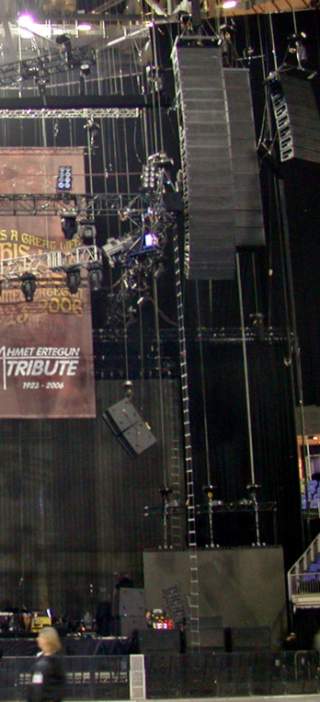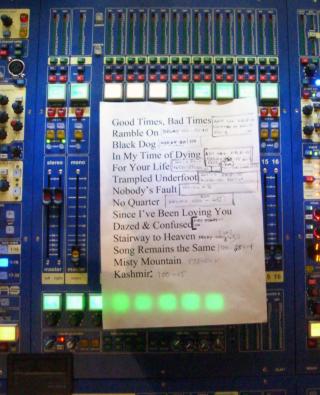| Pro-Music-News™ | Pro Audio |
| Index Pro Audio | Main Index English | Forums & Search Site |
Led Zeppelin perform at Ahmet Ertegun memorial concert at 02 arena
| With the frenzy of media and music industry interest in the show, there was a huge amount of pressure on UK rental companies Brittania Row and Major Tom Ltd. which together provided the show’s entire audio requirements including an FOH Meyer Sound system as well as higly sophisticated Earthworks microphones or state of the art digital gear such as a Midas XL8 mixing console, to deliver a sound which lived up to everyone’s expectations - and a large part of the considerable pressure fell on the shoulders of Front of House engineer ‘Big’ Mick Hughes (Metallica), Robert Plant's FOH Roy Williams, and Dee Miller at the monitor position. Should the FOH sound replicate Zeppelin as they sounded in the 1970s, or should the sound be more modern, taking advantage of the intervening three decades of audio technology development? “At first I tried to listen to all the opinions, but in the end I knew that I had to just do it in a way that the band was happy with and that I thought would work,” says Mick. “So I had a lot of discussions with them during rehearsals and approached it the way I thought best. “I took the modern approach and backdated the sound a little bit, although I pulled it back a bit from recreating the old sound too much. For example, I went for the ‘airy’ feel, but to avoid the big, gated drum sound. I just had a loose gate on the bass drum, but the rest were ungated.” Major Tom Ltd deployed a Meyer Sound sound system comprised of 72 MILO curvilinear loudspeakers, with a center hang of six MICA curvilinear loudspeakers, and ten flown 700-HP subwoofers per side. Ground stacks included nine 700-HPs per side, and four MICAs per side for outfill. In addition, one MICA per side along with eight UPA-1Ps were strung across the stage lip for front fills. Three Galileo loudspeaker management systems handled 36 outputs, and a SIM 3 audio analyzer was used by Meyer Sound's Director of European Technical Support Luke Jenks to tune the system. Lars Brogaard, whose rental company Major Tom Ltd. provided the Meyer Sound system, was originally introduced to the project by Paul Owen, vice president of US-based rental company Thunder Audio. Over the past several years, the two companies have worked closely to provide sound systems for Metallica, Robert Plant, John Legend, Diana Ross and Rod Stewart. Brogaard highlights modern rigging hardware as a key advancement since the days when Led Zeppelin toured regularly. "At a gig like this, you have only a few hours to fly everything and make sure all the speakers are exactly where they should be," says Brogaard. "Modern boxes like MILO are properly set up for this kind of operation and so, we had no problems whatsoever. There is just no comparison with setting up for a gig in the '70s." Thus, everything was ready to please the audience with exactly the sound Big Mick and Roy Williams would go for. This was the first time Big Mick had done a show in the O2 arena and only his second time of using a Midas XL8 console ‘in anger’, as it were. “It was quite bizarre at first,” says Mick. “Because I’ve been working with Metallica for over 20 years, we have developed their live sound over that time. Nobody can tell me what Metallica should sound like live. But, when it came to the Zeppelin show, it seemed that everyone and their dog had an opinion of what the band should sound like!” "I was in a dilemma," says Hughes, who was concerned that diehard fans who'd paid thousands of dollars for tickets might resent any attempt to update the classic Led Zeppelin sound. In the end, Big Mick's love of bottom end proved a decisive factor: "I listened back to some of the old bootleg albums that were made of Led Zeppelin gigs in the '70s, and really, there is no bass on them at all—not because you couldn't record it, but because the sound reinforcement systems at the time couldn't reproduce it. At the risk of upsetting the purists, I decided that the gig had to sound like it was 2007. So we mixed it as if Led Zeppelin had never stopped playing in the time since their last gig, 27 years earlier." With sound technology having changed so much in the intervening years, microphone selection was something that Mick had to consider very carefully. With so many specialised products now available, the inventive use of certain mics for their non-intended purpose is no longer necessary, but that would inevitably change the sound. “On the old footage, it’s incredible to see what mics were used on what jobs,” says Mick. “I approached it using similar techniques, but using modern mics and the full bandwidth of the console and PA.” To achieve optimum sound quality, Mick used an array of Earthworks Audio high definition microphones, complemented by Audio-Technica and Shure products. Jason Bonham’s drums featured a mix of Earthworks SR25s, SR30s and TC30s, with Audio-Technica ATM350s on the toms, a Shure SM57 and a Beta 52. “I really wanted to recreate that big, open Led Zeppelin drum sound,” he says. “So as well as the close mics, I used a pair of Earthworks SR25s arrayed as X-Y axis mics, which is something I’d never done before, complemented by a further pair of SR25s deployed as overheads.” One of the advantages of the Earthworks microphones was that the company manufactures the KickPad, a little inline unit that adds pre-emphasis to kick drum mics, adding presence and punch to a sound that often needs a little extra zip to make it stand out in a live mix. A mixture if DIs and Beta 52s were used on John Paul Jones’s bass guitar, bass pedal and keyboard rig, while Jimmy Page’s guitar cabinets and Theremin featured Audio-Technica AE 2500s and 4050s. Robert Plant’s lead vocals came courtesy of the Shure SM58. The total was 32 inputs, including a couple of VT playback lines from the video production team. “Although I’m mainly an analogue guy, and this was only my second outing in the digital world, I had used the XL8 on stadium dates with Metallica last year and loved it,” says Mick. “I did toy with using an XL4, but the show was a bit of an unknown quantity before we got into rehearsals and it would have been hard to plan ahead on an analogue console. For example, planning every last bit of outboard we needed would have been a problem, especially the logistical issue of if we’d had to try and hire in another effects unit at the last moment. But with the XL8 we were able to simply dial in the onboard effects as required. As it was, we ended up with a total of 70 channels, including 30 effects returns, the video playback, house music and so on.” Another area where having a digital console was very useful was the unsual split of the FOH mix between Hughes mixing the instruments and Roy Williams covering the lead vocal mix. “With the XL8, we were able to allocate the faders in the end bay to the vocal mix, so Roy was able to be very self-contained at one end of the console,” says Mick. “The band was playing in an adjacent room while I was monitoring on a pair of Genelecs,” Big Mick comments his work during the six weeks of rehearsals, recording the band with Klark Tekniks new digital live recorder DN9696. “I didn’t know what the band’s work ethic was, so the DN9696 gave me the opportunity to record the sessions and then, if the band weren’t there, to work on the mix further. “We identified a phase problem between the microphones on the snare heads and the X-Y mics, because the snare sound was reaching them at different times” he says. “The recorder allowed us to precisely measure the time difference and we then used the delays on the input channels of the XL8 to delay the snare mics and make the sound effectively ‘reach’ the different mics at the same time.” Despite the early ‘unknowns’ of the show, Mick complemented the onboard processing of the XL8 with a range of outboard equipment, including a Roland SDE3000, TC Helicon VoiceWorks and VoiceDoubler for Plant’s lead vocals, an Eventide H3000SE harmoniser, TC Electronic M6000 effects mainframe and Leslie cabinet emulator. But the onboard effects proved the star of the show on No Quarter, the XL8’s phaser providing the distinctive effect on the lead vocal. As well as the live mix, an isolated feed was provided to the Fleetwood Mobile, manned by Tim Summerhayes, where every note and nuance if the show was recorded. |
 Links:Follow this link to learn about how Led Zeppelin had a blast on stage with Dee Millers monitor mix. Read here about the lighting and the video production at the Ahmet Ertegun Memorial show with Led Zeppelin on December 10, 2007. |